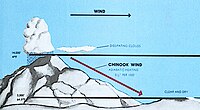
Photo from wikipedia
Shelf currents are formed by the wind, tides, and pressure gradient. Wind is usually the dominant energy source for coastal currents. This paper considers the formation of the coastal current… Click to show full abstract
Shelf currents are formed by the wind, tides, and pressure gradient. Wind is usually the dominant energy source for coastal currents. This paper considers the formation of the coastal current under the effect of push-off wind and its influence on the thermohaline structure of Peter the Great Bay waters. When wind increases, a strong coastal current forms along the isobath and a transverse shelf flow is directed from shore in the upper layer. The push-off wind forms a two-layer circulation with ascending water in the lower layer and a feeder current in the upper layer. The flow in the upper layer causes sea level to drop and temperature to decrease. When the wind increases, anticyclonic circulation is formed to the right of the wind jet axis. The current velocity near the western shore of the bay reached 0.8 m/s and was directed northeast along the isobath. The coastal flow is triggered by a level tilt caused by the push-wind.
Journal Title: Oceanology
Year Published: 2020
Link to full text (if available)
Share on Social Media: Sign Up to like & get
recommendations!